Optimization of Vacuum-Applied UV-Curable Coatings Performance

UCB Chemicals Corp. has introduced low-viscosity epoxy, urethane and polyester acrylate resins that can be used at relatively high concentrations in vacuum-applied coatings.2-3 Starting point formulations for clearcoats based on the different types of oligomers will be presented in this article. Selection of the resin, or a blend of two or more products, allows formulators to control the coating reactivity, flexibility and impact resistance. Table 1 summarizes the properties of the oligomers we manufacture that have been used to prepare vacuum-applied clearcoats.
Thickness of vacuum-applied coatings can be controlled by changes in the vacuum level and coating line speed, with higher vacuum levels and lower line speeds resulting in thinner coatings. 4 We have quantitated the effect of instrumental settings on the amount of coating applied using a vacuum coater and formulations of different viscosity to determine the relative effectiveness of these parameters in controlling the applied weight and coating appearance.

Experimental
Formulations were prepared by blending acrylate oligomer, monomer, photoinitiator and additives with a low-speed mixer at room temperature. Table 2 shows starting point formulations based on acrylated epoxy, urethane and polyester resins recommended for vacuum coating applications. Oligomer and diluent concentrations have been adjusted to give a viscosity of 200 + 30 cP at 25 deg C.Table 3 presents the formulations used to evaluate the effect of instrumentation parameters. Viscosity at 25 deg C was measured with a Brookfield RVDV-II+ viscometer at 10 and 100 rpm. Both formulations containing silica showed shear thinning (Table 3).
Ebecryl(r) 81 (amine-modified polyester acrylate), Eb 3212, Eb 8402, Ebecryl 810, TRPGDA (difunctional acrylate monomer), and OTA-480 (trifunctional acrylate monomer) are produced by UCB Chemicals Corp. Syloid(r) 161 and Acematt(r) TS 100 are silicas supplied by Grace Davison and Degussa, respectively. TegoFlow(r) 425 is a flow modifier and TegoAirex(r) 920 is a silicone-free defoamer produced by Tego Chemie. The photoinitiator, Irgacure(r) 500, was purchased from Ciba Specialty Chemicals.
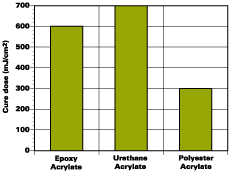
Vacuum coating experiments were conducted with a Delle Vedove vacuum coater/curing unit combination equipped with medium pressure mercury lamps. Two layers were applied and the coating weight was estimated by weighing the substrate before and after application.
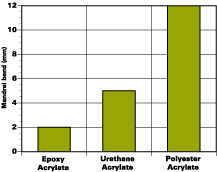
Results and Discussion
Evaluation of Acrylated Epoxy,Urethane and Polyester Resins
Formulations shown in Table 2 were applied on steel panels with a #5 drawdown bar to determine their photoresponse and properties of the cured coatings. All formulations produced cured coatings with gloss values at 60 deg between 90 and 100, and pencil hardness of 8H or higher.
Figure 1 shows the photoresponse of the formulations indicated in Table 2. The high photoresponse obtained for the formulation based on the polyester acrylate is related to the faster oxygen consumption commonly obtained with amine-modified oligomers.

Vacuum coating results, obtained with the coatings shown in Table 2, can be summarized as follows.
- Cured coatings with excellent appearance were obtained in all cases.
- Sandability was good although fillers are not being used.
- Intercoat adhesion was excellent provided the previous layer was sanded.
- Impact resistance was good. It was tested with a hammer, checking for cracks and delamination at the point of impact.
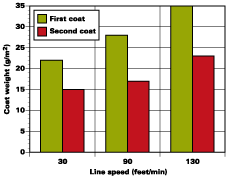
Vacuum level = 6" Hg
- Gauge vacuum level was either 4" or 6" Hg. The levels are limited by the particular instrument vacuum manifold.
- Coating line speed was 30, 90 and 130 feet/min. Corresponding residence times in the coating chamber are 1.7, 0.6 and 0.4 seconds, respectively.
- Curing speed was kept at 150 feet/min.
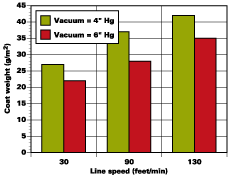
Figure 4 shows the results obtained with the low-viscosity formulation (130 cP at 10 and 100 rpm) at different line speeds and a vacuum level of 6" Hg. The first coat is 50-60% heavier than the second coat, a result that is independent of the vacuum level, coating line speed and viscosity of the formulation.
This result has sometimes been attributed to diving of the coating into the substrate. This explanation is unsatisfactory since penetration into the substrate increases with decreasing viscosity and increasing contact time. In contrast, our results show that the percentage difference in coat weight is independent of formulation viscosity and residence time. Considering the actual difference between coatings (in g/m2) we observe that higher differences are obtained with increasing viscosity and decreasing residence time in the coating chamber.

Increasing the vacuum level leads to lower coating weight (see Figure 5), with similar results being obtained for the second coat. A reduction of (20 + 5)% was obtained when the vacuum level was changed from 4'' to 6" Hg, irrespective of the line speed and formulation viscosity.
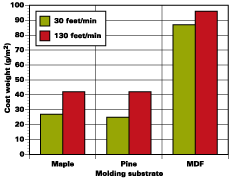
Using 6" Hg for the vacuum level we observed that the pump speed has no influence in the amount of coating applied. A minimum pump speed is required for the liquid to reach the coating chamber, beyond which the applied weight becomes independent of the pump setting. This result was expected based on the instrument specifications.4
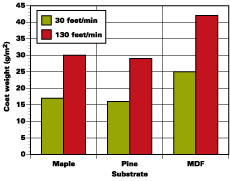
Vacuum level = 4" Hg
Pine and MDF Moldings
Moldings made of pine and MDF were used to examine the effect of the substrate on the applied coat weight. Figures 7-8 present the results at different line speed and a vacuum level of 4" Hg. Sanding of the molding or the first coating layer has no effect on the results.
Results with pine moldings are similar to those obtained with maple both in terms of the applied coating weight and the variation with increasing line speed.
The first layer applied to MDF molding is significantly higher than obtained with the other two substrates under the same conditions, and the coating weight is insensitive to variations in the line speed (see Figure 7). The effect of line speed on the second coating layer is the same for the three substrates (see Figure 8). Changing the line speed from 30 to 130 feet/min increases the coating weight by approximately 75%.
Conclusion
Within the range examined, variation in coating line speed is more effective in controlling the weight of applied coating than changes in the vacuum level. The viscosity of the formulation affects the cured coating appearance by altering the coat weight as well as by determining the flow and air release characteristics. Increasing the vacuum level, lowering the line speed and using lower viscosity coatings result in thinner coating being applied to the substrate. These guidelines are not valid for the first layer applied to MDF moldings, as the coat weight seems to be insensitive to changes in line speed.This article was presented at The 2002 RadTech International North America meeting, Indianapolis.
For more information on UV-curable coatings, contact Oscar Valdes-Aguilera, UCB Chemicals Corp., 1900 Lake Park Drive, Suite 345, Smyrna, GA 30080.
References
1 Bates, C.A., RadTech Report, November/December 1998, 19.2 Cox, B.; Dulany, L.; Valdes-Aguilera, O. PCI, April 1999, 60.
3 Valdes-Aguilera, O. Modern Paint & Coatings, December 2000, 17.
4 Delle Vedove USA. UVC Reference Manual, 4.
Looking for a reprint of this article?
From high-res PDFs to custom plaques, order your copy today!




